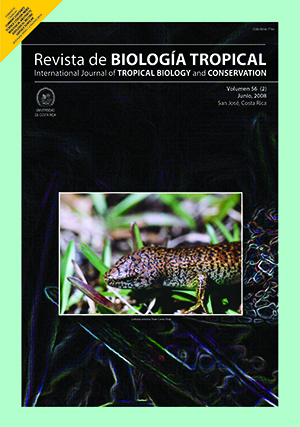Abstract
Composition and abundance of the ichthyofauna in estuarine and coastal lagoon systems of the South Pacific in Mexico have been scarcely studied. In particular, there is a lack of information on how environmental variables determine the spatio-temporal structure of fish assemblages in those habitats. In this study, fishes were sampled by drop net during twelve months (May 2004 - April 2005) in 22 sites distributed along the Carretas-Pereyra lagoon, located in the Biosphere Reserve La Encrucijada, Chiapas, Mexico. We recorded 11 797 individuals (40 species, in 30 genera and 21 families). Dormitator latifrons was the most dominant species in terms of the Importance Value index, IV (23.05 %), followed by Lile gracilis (10.31 %), Poecilia sphenops (8.60 %) and Poecilia butleri (7.30 %). D. latifrons also accounted for more than one half of the total biomass (50.14 %). Species richness and Shannon-Wiener?s diversity indexes showed similar temporal fluctuations, reaching their highest values during the dry season. The system evidenced temporal ariations in salinity, having observed four different regimes: freshwater, oligohaline, mesohaline and polyhaline. Mean richness and diversity indexes achieved their highest values during the mesohaline period. On the other hand, mean abundances (CPUE) were highest during the freshwater period. Canonical correspondence analysis (CCA) indicated that salinity and temperature were the most important environmental parameters affecting associations of fishes in terms of their abundances. Correlation analyses revealed that among the environmental variables measured in this study, transparency showed the most significant negative correlation with fish richness and Shannon-Wiener?s diversity index. At a local scale, results suggest that spatial and temporal distribution of fish assemblages are determined by differences in the regimes of salinity and transparency, primarily driven by freshwater input from rivers.Comments

This work is licensed under a Creative Commons Attribution 4.0 International License.
Copyright (c) 2008 Revista de Biología Tropical
Downloads
Download data is not yet available.






